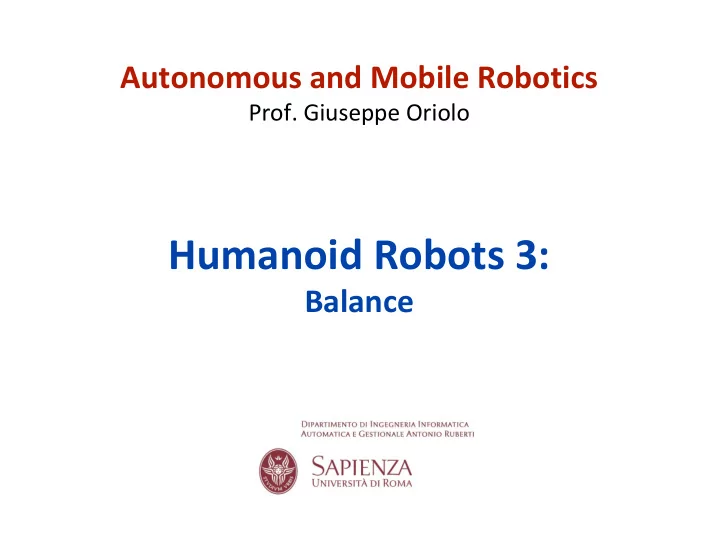

Autonomous and Mobile Robotics Prof. Giuseppe Oriolo Humanoid Robots 3: Balance
recap • sufficient condition for balance: ZMP inside the support polygon • ZMP dynamics modeled from Newton-Euler equations • approximate model: Linear Inverted Pendulum (LIP) Oriolo: Autonomous and Mobile Robotics - Humanoid Robots 3 2
Linear Inverted Pendulum: basic scope Although extremely simplified, the LIP equation describes in first approximation the time evolution of the CoM trajectory. Moreover • it defines a differential relationship between the CoM trajectory and the ZMP (or CMP) time evolution • it is easier to design a controller which makes the actual CoM follow a desired behaviour • dynamic balancing will be characterized in terms of the ZMP • the problem will then be to understand which CoM trajectory, solution of the LIP equation, guarantees that dynamic balancing is achieved Oriolo: Autonomous and Mobile Robotics - Humanoid Robots 3 3
ZMP vertical component of the GRF Support Polygons during Double Support Oriolo: Autonomous and Mobile Robotics - Humanoid Robots 3 4
ZMP - 2D case components of the GRF equivalent force/torque CoP/ZMP generic p x specific p x Oriolo: Autonomous and Mobile Robotics - Humanoid Robots 3 5
ZMP - 3D case vertical component of the GRF Oriolo: Autonomous and Mobile Robotics - Humanoid Robots 3 6
ZMP - 3D case horizontal component of the GRF if robot moves, the z component will be different from 0 Oriolo: Autonomous and Mobile Robotics - Humanoid Robots 3 7
ZMP z z as long as the ZMP is in the Support Polygon, the support foot will not rotate Oriolo: Autonomous and Mobile Robotics - Humanoid Robots 3 8
ZMP Oriolo: Autonomous and Mobile Robotics - Humanoid Robots 3 9
static balance if the CoM stays within these boundaries no tipping over occurs humanoid motionless : statically balanced robots keep the center of mass within the polygon of support in order to maintain postural stability (sufficient when the robot moves statically statically slow enough so all the inertial forces are negligible) unbalanced balanced M M M equivalent representation: mass M on a massless table with finite length base the table starts tipping over Oriolo: Autonomous and Mobile Robotics - Humanoid Robots 3 10
dynamic balance Question : Answer : how do you keep a pendulum by continuously accelerating it in a non-vertical position? non-inertial frame inertial force (fictitious force) (pendulum stands still in an accelerating frame) M acceleration gravity Hyp : no torque around the CoM force GRF Oriolo: Autonomous and Mobile Robotics - Humanoid Robots 3 11
dynamic balance humanoid walking : the GRF will also have a component parallel to the ground; the motion requires the exchange of horizontal frictional force with the ground hyp: no torque around the CoM acceleration inertial force gravity force GRF Oriolo: Autonomous and Mobile Robotics - Humanoid Robots 3 12
dynamic balance Ground Reaction Force (GRF): 2D components ( x , z ) hyp : no torque around the CoM from the previous derivation: GRF acceleration z inertial = Mg GRF force gravity force x GRF = GRF Oriolo: Autonomous and Mobile Robotics - Humanoid Robots 3 13
which robot falls down? Oriolo: Autonomous and Mobile Robotics - Humanoid Robots 3 14
which robot falls down? inertial force statically dynamically falls balanced balanced Oriolo: Autonomous and Mobile Robotics - Humanoid Robots 3 15
where is the ZMP? z x (ZMP): point on the ground where the GRF is applied use the dynamics equation on horizontal flat ground and neglect Oriolo: Autonomous and Mobile Robotics - Humanoid Robots 3 16
where is the ZMP? LIP equation hyp CoM at constant height in the sagittal plane inertial force statically dynamically falls balanced balanced Oriolo: Autonomous and Mobile Robotics - Humanoid Robots 3 17
what if CoM acceleration is increased? vertical from the previous analysis one could think that the ZMP, acceleration increasing the CoM acceleration, would leave the support foot is generated support, but it doesn’t • once the ZMP has reached the foot border, a rotation starts inertial around that point force gravity • with the rotation of the foot, the center of mass starts accelerating vertically inertial • with a vertical acceleration of the CoM, its height does not force remain constant • model changes, ZMP remains constant the vertical CoM acceleration generates a vertical inertial force Oriolo: Autonomous and Mobile Robotics - Humanoid Robots 3 18
dynamically balanced + torque ¿ y around the CoM Hyp : no torque around the CoM sum of moments around z x ¿ y c z c z Centroidal Moment Point z x c x z x c x CMP Oriolo: Autonomous and Mobile Robotics - Humanoid Robots 3 19
dynamically balanced + torque ¿ y around the CoM (or equivalently an ankle torque ¿ y ) positive torque ¿ y (counter-clockwise) moves the Center of Pressure CoP to the right z x is not the CoP anymore CoP ¿ y c z ¿ y ¿ y ¿ y ¿ y z x c x CoP CoP Oriolo: Autonomous and Mobile Robotics - Humanoid Robots 3 20
dynamically balanced locomotion generate a gait for walking while maintaining balance maintaining assumed to be not tipping over the balance equivalent to support foot ZMP needs to ZMP-based stay inside the criterion Support Polygon Oriolo: Autonomous and Mobile Robotics - Humanoid Robots 3 21
Recommend
More recommend